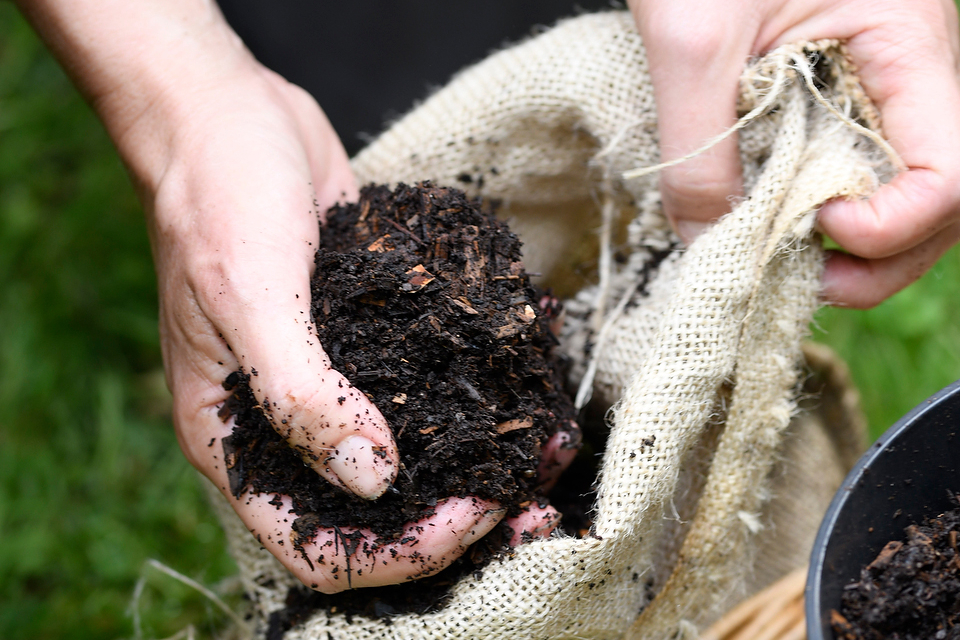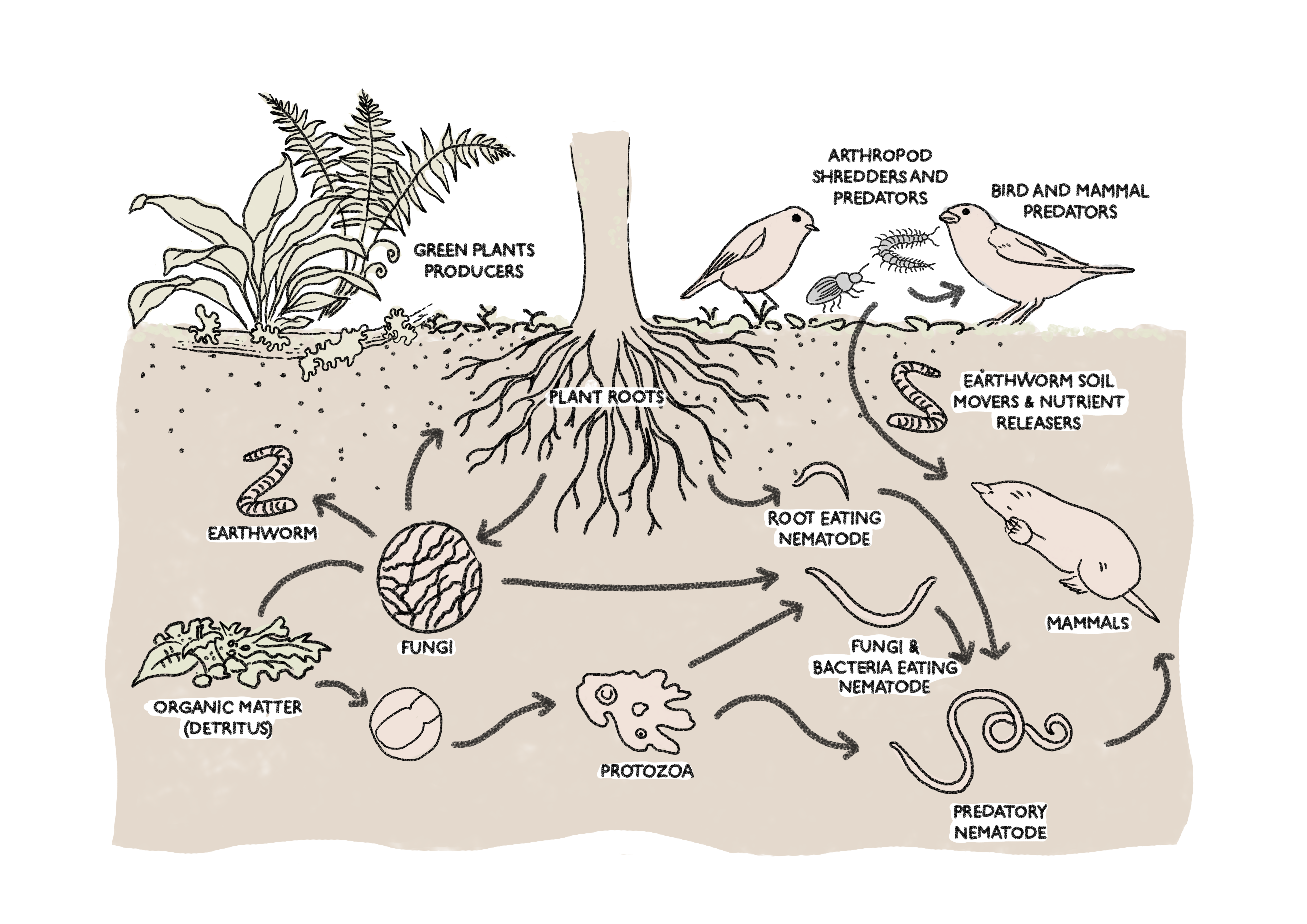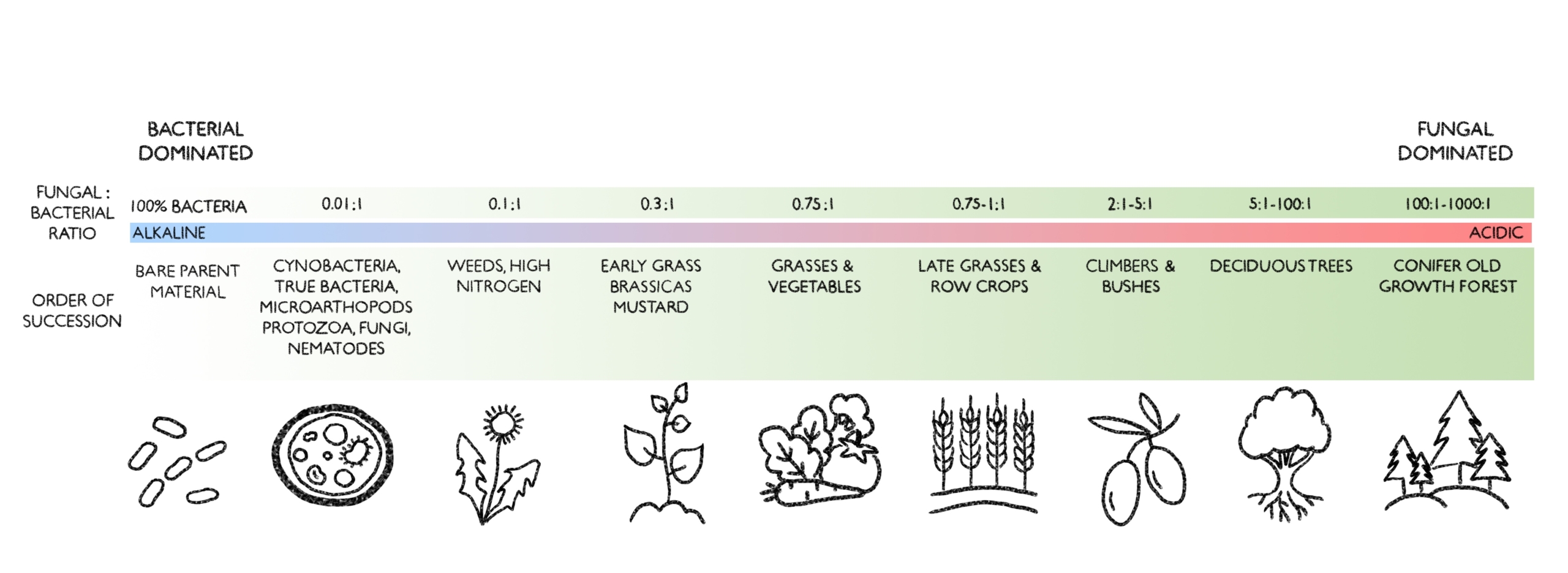UNDERSTANDING SOIL IN OUR GARDENS
“A soft symphony of sounds emanates from the soil within a forest and the more thriving the ecosystem, the greater the diversity of noise.”
– New Scientist
How does our soil biology impact our gardens on a practical level?
To answer this, let’s look below ground. To have a fully functioning soil microbiome we need enough bacteria, fungi, protozoa and nematodes to feed plants, in the proportion for the type of plants we want to grow, and to minimise the microbes that will harm our plants.
A soil that is in an early succession phase through being disturbed or damaged is highly bacterial. Bacteria are the early clean-up crew, eating simply and multiplying rapidly. If the soil microbes are more in balance there will also be plenty of protozoa, amoebae and nematodes further up the food chain, and lots of fungi. A typical vegetable garden needs as much fungi in the soil as bacteria, at least 135 micrograms of each per gram of soil. As the plants above ground become more complex and woody, these plants will thrive in more fungal-dominated conditions, wanting a balance of between 1:100 and 1:500 bacteria: fungi for shrubs and a whopping 1:50,000 for old growth forest (see chart below).
Only early succession plant life will be supported above ground if the microherd is predominantly bacteria. If you have frequently disturbed, compacted or poisoned ground or a garden with minimal organic matter, it will mostly support ‘weeds’, wildflowers and some pioneer shrubs. In a brownfield garden with minimal topsoil the plants grow ‘hard’ and will be tough, often very floriferous and still excellent for pollinators but not for mammals that need higher nutrient food plants. These gardens have early succession soils as in the diagram below.
Many agricultural soils that have been over-tilled, weedkilled and over-fertilised are also highly bacterial and low in other available nutrients. If they have too much manure, they may be very rich but rich in bacteria – what soil guru Nicole Masters calls ‘constipated soil’. The nutrients can’t get from the soil to the plant without the protozoa nematodes and microarthropods, so farmers rely on artificial inputs like chemical nitrogen (N), phosphorus (P) and potassium (K) to feed the crop. How much cheaper it would be to create the conditions for healthy roots and allow the plant and a fully diverse herd of microbes to gather what they need.
Some gardeners also rely on chemical fertilisers. These give a quick flush of ‘fast food’ with N, P and/or K supplied to plants in a quickly available form. Plants may grow fast and soft but the problem is that these fertilisers are made predominantly of salts, which kill the microbes in the soil whose job it is to feed the plants exactly what the plant needs, from a much wider spectrum of minerals and metabolites than N, P and K. This creates a vicious circle, as without the microbes the plants become dependent on fertilisers, making fertiliser-sellers richer and our soil and food poorer.
As gardeners we are generally trained to think of pH as the baseline for our soil, to choose plants that thrive in more acid or alkaline soils, or manipulate the pH with lime (to make it more alkaline) or sulphur (more acidic). Once we understand the succession chart below, it makes sense that grassland soils are naturally more alkaline and forests more acidic. When we want to create grass, meadow, vegetable garden or woodland edge habitats we can help our soil microbiome supply what our ecosystems need naturally.
How does this work? Plants put out foods, or exudates, through their roots to feed the microbes in return for nutrients. Bacteria consume these exudates and convert them into nitrates, and fungi consume them (humic acids, to be specific) and synthesise ammonium. Nitrates make soils more alkaline, and ammonium makes soils more acidic.
At the beginning of the succession (on the left of the diagram), bacteria count is high, and fungi count is low. This means that the most prevalent nutrient is nitrates (NO3); these are perfect for grasses and ‘weeds’. As we move towards more complex systems, there is proportionally higher fungi to bacteria count in soils. This means that the most prevalent nutrient is ammonium (NH4), therefore the soil is more acidic. What grows best in these soils? Perennials, shrubs and, finally, trees.
Once we understand this, rather than dumping lime or sulphur on to our soil, we can make sure to curate our microbes, feeding our bacterial herd if we need to disturb the soil in earlier succession planting, and increasing our fungal herd if we want later succession plants.
If you want to know how well your soil supports your desired plants you can learn to look at it under a microscope or have it tested by one of an increasing number of dedicated soil technicians, who will send you a report and describe who does what. They may even share images of your underground herd with you via video link, but beware! Once you see the crazy, little, packman-type ciliates (a type of protozoa that whizzes around eating all the bacteria they can bump into) or the slow moseying gait of the tardigrade or moss piglet (a creature so cute but indestructible that they can survive outer space) you may be hooked! Soil will never look the same again.
Soil Succession
To have a fully functioning soil microbiome we need enough bacteria, fungi, protozoa and nematodes in the correct proportion to feed the plants we want to grow plants. Soils naturally go through a succession of typologies over time from highly bacterial to highly fungal. By understanding where our soils are on this path, we can understand how to work with rather than against nature in our gardens and landscapes.
Succession 1: Bacteria
After a major disturbance like a volcanic eruption, earthquake or fire, rocks are bare and the mineral or parent material is exposed. Bacteria alone is present.
Succession 2: First microbial activity
The first colonisers are bacteria, which can multiply every 20 minutes with sufficient food. These are followed by their predators: protozoa, nematodes, fungi and microarthropods. If there is no repeated disturbance, lichens and mosses will grow and hold water like sponges, begin to decompose and create organic matter.
Succession 3: Weeds
Bacteria-tolerant, early pioneer plants, which are fast growing, such as the seed-dispersing annuals scarlet pimpernel (Anagallis arvensis) and chickweed (Stellaria media), begin to scramble along the surface. Deep-rooted perennials like bindweed (Convolvulus), docks (Rumex) and nettles (Urtica) send roots down to pull up nutrients. As they decompose, they create nutrients and organic matter for more herbaceous plants.
Succession 4: Early brassicas, mustards and grasses
These are nutrient scavengers that grow fast: they may have deep roots to break up compacted soil. As they die, they make the nitrogen they have accumulated available to other plants like grasses and forbs, with a network of roots beginning to form below ground and a community of insects above ground.
Succession 5: Grasses and perennials
When the fungus to bacteria ratio is 0.75:1 herbaceous plants will dominate and a thick sward will develop.
Succession 6
With equal numbers of fungi and bacteria in the soil, there is an ideal environment for most crops, and such soil is a highly productive for horticulture.
Succession 7
As fungi begin to prevail over bacteria in the soil, climbers and shrubs are able to grow and soil becomes gradually more acidic.
Succession 8
Deciduous trees and woodlands begin to thrive once there is a fungi to bacteria ratio between 5:1 and 500:1. Soil is more acidic, and underground fungal networks become established.
Succession 9
Old growth forest and conifers live at the extreme of fungal-dominated soils. These will survive for centuries unless a major disturbance event like fire or landslide returns them to an earlier stage in succession and allows earlier succession species to dominate in some areas.
Photo © Jason Ingram. Diagrams © MBLA based on work of Elaine Ingham.


